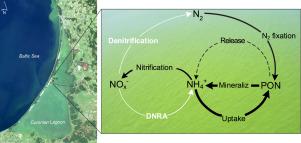Water Research ( IF 12.8 ) Pub Date : 2021-02-21 , DOI: 10.1016/j.watres.2021.116954 Elias Broman , Mindaugas Zilius , Aurelija Samuiloviene , Irma Vybernaite-Lubiene , Tobia Politi , Isabell Klawonn , Maren Voss , Francisco J.A. Nascimento , Stefano Bonaglia

|
Since the start of synthetic fertilizer production more than a hundred years ago, the coastal ocean has been exposed to increasing nutrient loading, which has led to eutrophication and extensive algal blooms. Such hypereutrophic waters might harbor anaerobic nitrogen (N) cycling processes due to low-oxygen microniches associated with abundant organic particles, but studies on nitrate reduction in coastal pelagic environments are scarce. Here, we report on 15N isotope-labeling experiments, metagenome, and RT-qPCR data from a large hypereutrophic lagoon indicating that dissimilatory nitrate reduction to ammonium (DNRA) and denitrification were active processes, even though the bulk water was fully oxygenated (> 224 µM O2). DNRA in the bottom water corresponded to 83% of whole-ecosystem DNRA (water + sediment), while denitrification was predominant in the sediment. Microbial taxa important for DNRA according to the metagenomic data were dominated by Bacteroidetes (genus Parabacteroides) and Proteobacteria (genus Wolinella), while denitrification was mainly associated with proteobacterial genera Pseudomonas, Achromobacter, and Brucella. The metagenomic and microscopy data suggest that these anaerobic processes were likely occurring in low-oxygen microniches related to extensive growth of filamentous cyanobacteria, including diazotrophic Dolichospermum and non-diazotrophic Planktothrix. By summing the total nitrate fluxes through DNRA and denitrification, it results that DNRA retains approximately one fifth (19%) of the fixed N that goes through the nitrate pool. This is noteworthy as DNRA represents thus a very important recycling mechanism for fixed N, which sustains algal proliferation and leads to further enhancement of eutrophication in these endangered ecosystems.
中文翻译:

活跃的DNRA和含氧过富营养水域中的反硝化作用
自从一百多年前开始生产合成肥料以来,沿海海洋就面临着不断增加的养分负荷,这导致了富营养化和藻类大量繁殖。由于富含有机物颗粒的低氧微生态位,此类富营养化的水可能具有厌氧氮(N)循环过程,但是在沿海中上层环境中减少硝酸盐的研究却很少。在这里,我们报告了来自一个大型富营养化泻湖的15 N同位素标记实验,元基因组和RT-qPCR数据,这些数据表明,即使大量水被完全充氧,硝酸盐异化还原为铵(DNRA)和反硝化也是活跃的过程(> 224微摩尔O 2)。底部水中的DNRA占整个生态系统DNRA(水+沉积物)的83%,而沉积物中的反硝化作用最为明显。根据宏基因组学数据,对DNRA重要的微生物类群主要是拟杆菌属(副杆菌属)和变形杆菌(沃林氏菌属),而反硝化作用主要与变形杆菌属假单胞菌属,无色杆菌属和布鲁氏菌属有关。宏基因组学和显微镜数据表明,这些厌氧过程可能发生在与丝状蓝细菌的广泛生长相关的低氧微生态位中,包括重氮营养的Dolichospermum和非营养营养的Planktothrix。。通过对通过DNRA和反硝化作用的总硝酸盐通量求和,得出的结果是DNRA保留了流经硝酸盐池的固定氮的大约五分之一(19%)。值得注意的是,DNRA代表着固定氮的非常重要的回收机制,该机制可维持藻类增殖并导致这些濒危生态系统中的富营养化进一步增强。



























 京公网安备 11010802027423号
京公网安备 11010802027423号